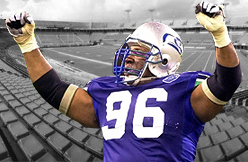DALLAS -- All defensive tackles were not created alike. That goes for the great ones, too.
Some are mostly run-stuffers, coming off the field in passing situations. Others rush the passer with little or no regard for playing the run.
Very few could dominate across all situations. Cortez Kennedy could, and did, during an 11-year NFL career that landed him a spot among the final 10 candidates for the most recent Pro Football Hall of Fame class. Kennedy is among the final 15 modern-era finalists again this year, and I'll be presenting his case to the other selectors during our annual meeting Saturday.
Several themes have emerged during my research into Kennedy's career. I'll expand upon them here one by one, drawing upon coaches and players' first-hand knowledge.
Sheer physical dominance
Very good players sometimes enjoy great careers. Some lean heavily on savvy and preparation. Not all of them dominate physically. Kennedy generated superior power and sudden quickness from a massive lower body.
"Cortez was the most dominant interior lineman that we ever faced and certainly the very best against the run," said former Oakland Raiders guard Steve Wisniewski, an eight-time Pro Bowl choice between 1989 and 2001.
Seattle scrapped its 3-4 defense to rebuild around Kennedy at a time when Kennedy's college coach at Miami, Jimmy Johnson, was bringing his 4-3 scheme to the NFL.
"That time in football is when you really got the dominant defensive players inside," Johnson said. "The big, overpowering defensive linemen inside just disrupted everything. Cortez got teams looking for that dominant player."
There's that word again -- dominant.
"He was very dominant and could take over the game," said longtime NFL offensive line coach Howard Mudd, who coached for and against Seattle during Kennedy's career. "He just had great instincts about where the ball was and he was a pass-rusher so you would think, 'Gee, we could run screens on that guy.' But he smelled them out and he was always running into the screens."
Longtime NFL offensive line coach Alex Gibbs said offenses had to plan for Kennedy specifically or pay the consequences, or both. Gibbs coached the lines for three of Seattle's old AFC West rivals across 10 of Kennedy's 11 seasons. He was with Seattle briefly in 2010, and that is when he provided a testimonial.
"The Seahawks were a nightmare because I knew I was going to get them twice a year, and it was going to boil down to making a decision -- do I spend all my time with Cortez or do I know deal with those other guys?" Gibbs said.
Complete player
Kennedy joined John Randle, Bryant Young and Warren Sapp on the NFL's all-decade team for the 1990s. He was a different type of defensive tackle, opponents said. They lauded him for his versatility.
"I knew that when I was going to go play against Cortez Kennedy, it was going to be a full-meal deal, a battle," said retired Pro Bowl center Tim Grunhard, who started 164 games for Kansas City from 1990 to 2000. "I knew when I was going against Warren Sapp, when you got him, you could block him. ... At times, he lined up as wide as any tackle ever. Cortez Kennedy lined up head-on you and went man to man and dominated you."
Asked to rank Kennedy among contemporaries, Wisniewski wanted to know which tackles appeared on the all-decade team for the 1990s. I ran through the names and asked Wisniewski to put Kennedy's abilities in perspective.
"(Kennedy) had that ability to stop the run, to play with leverage and have the quickness to hit the edge of an offensive guard and split the seams to put pressure on the quarterback," Wisniewski said. "Hands down, he was a much better player against the run than a John Randle, much better than a Warren Sapp. I didn't have to play against Bryant Young as many times. He was a much lighter guy, kind of high effort, 50-50 (against run and pass alike)."
Randle is already in the Hall of Fame. Sapp and Young are not yet eligible for consideration. Each was outstanding in his own way, but Kennedy was different.
Made teammates better
Kennedy collected 14 sacks in 1992 and 58 for his career even though Seattle asked him to do so much more than rush the passer. Opponents funneled more resources toward Kennedy after that 14-sack season, creating opportunities for his teammates. Michael Sinclair, Sam Adams, Michael McCrary and others benefited.
"He was such a powerful guy who could play, in essence, two gaps," Gibbs said. "He forced you to get two people on him in order to get through the seams, which gave the linebackers who played here a tremendous advantage. You couldn’t get the combinations to block him. You always tried to get one of them off and his body frame was so wide and strong that we couldn’t get there, so the linebackers made all the plays. He had a unique ability to control one and force another to free up his teammates to make a lot of plays."
Former Seahawks linebacker Terry Wooden said the same thing recently when I happened to be sitting near him on an airplane. According to Wooden, Kennedy would never seek to make a play on his own if it meant weakening the defense overall or compromising a teammate.
Durability and accolades
Kennedy played 16 games nine times, 15 games once and eight games in his only injury-shortened season. He matched Reggie White and Bruce Smith as the only defensive linemen with eight Pro Bowls during the 1990s. He went to as many Pro Bowls during the 1990s as Jerry Rice, Deion Sanders, Emmitt Smith, Bruce Smith and Derrick Thomas.
Kennedy was also the Associated Press' defensive player of the year on that 2-14 team, which featured one of the worst offenses in NFL history (Seattle was the only NFL team to field a top-10 defense in 1990, 1991 and 1992). Only White and Lawrence Taylor won the award previously while playing for losing teams.
According to the Seahawks, Kennedy played more than 90 percent of the defensive snaps for at least his first six seasons, including 97.2 percent in 1994.
Since sacks became an official stat in 1982, Kennedy and Hall of Famer Randy White are the only defensive tackles with at least 150 starts, 50 sacks and eight Pro Bowls. Again, though, the sack totals were never what defined Kennedy's contributions.
Grunhard put it this way: "When they are 330 pounds, at times their job is to tie you up. Their job is to clog up the middle. It is not fair when people say they are taking plays off. They are doing their jobs. There is a difference. Sometimes plays aren't designed for them to make the plays. Their job is to free up other people and he did a great job doing that. But when Cortez wanted to go and had the opportunity to go make a play, he was unstoppable. He was unblockable. That puts him in an elite level."
(espn.com)



